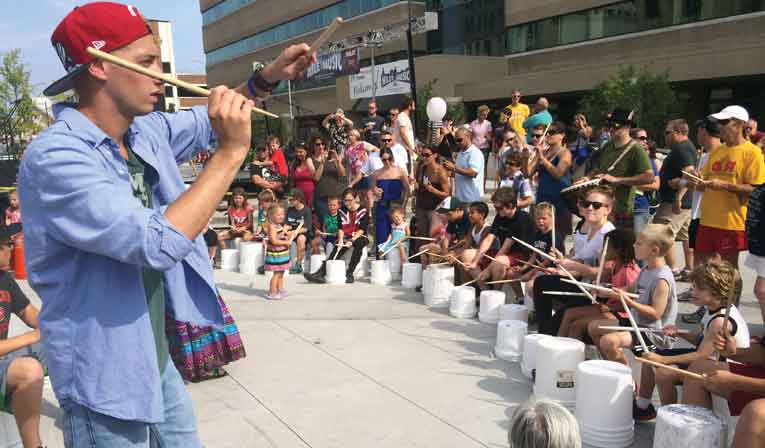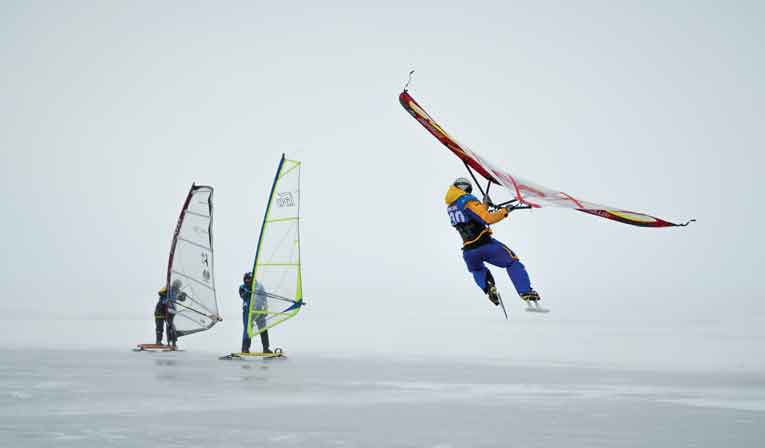Photo courtesy of Oshkosh Convention & Visitors Bureau
Wisconsin’s Lake Winnebago and the surrounding communities of Appleton, Fond du Lac, Oshkosh and Neenah offer visiting boaters a warm, friendly atmosphere with more than 1,000 events and festivals to keep you entertained, no matter the season.
I’m plopped cross-legged in the center of Appleton, Wisconsin’s Houdini Plaza, thumping an inverted paint bucket with a pair of wooden drumsticks. It’s a blue sky day pretty enough to make anyone sing, or, in our case, pound out some increasingly complicated rhythms — this unlikely band of toddlers in sundresses, teens in baseball caps, business people on a lunch break, fellow boaters, and me.
We’re taking a free drumming class. And it’s just one of dozens of activity options on the docket of the four-day Mile of Music Festival, where the music is original and you can’t really sit on the sidelines when surrounded by such a creative culture.
In one direction, a giant Cat in the Hat sits perched atop the Trout Museum of Art, the community-created art project broadcasting a Dr. Seuss exhibit within. To another, a stained glass tower blends the work of photographers and artists over the years, and from all directions waft the sometimes-competing sounds of singer/songwriters. Some 200 bands are in town, playing 600 or so all-free concerts inside taverns, restaurants, brew pubs, chapels, pizza parlors, auditoriums and parks.
Whether Wisconsin’s Lake Winnebago is what inspires creative fun like this is up for debate, but it’s surely no coincidence that port towns lining the lake throw well over a thousand festivals each year, on top of weekly outdoor concerts, markets and film fests under the stars. Nature’s art is the focus along the east side, the section most notable for rocky cliffs and striking viewscapes. And there’s a soundtrack here to suit most any trip’s desire: Original singer/songwriter tunes that form the focus of this festival, at which Norah Jones once appeared, others devoted to rock, country and contemporary Christian tunes, or perhaps just the iPod on your boat as you sail or motor across the nation’s second largest inland freshwater lake.

Photo by Kim Schneider
Sturgeon of Winnebago
 The story of the Lake Winnebago sturgeon is part environmental success story, part cultural spectacle almost too strange to be true. Picture thousands of shanties pitched on the frozen lake, fishermen inside waiting with spears to, in that most ancient of fishing means, capture ancient fish sometimes taller, older (up to 100 years) and heavier (at up to 200 pounds) than the humans catching them.
The story of the Lake Winnebago sturgeon is part environmental success story, part cultural spectacle almost too strange to be true. Picture thousands of shanties pitched on the frozen lake, fishermen inside waiting with spears to, in that most ancient of fishing means, capture ancient fish sometimes taller, older (up to 100 years) and heavier (at up to 200 pounds) than the humans catching them.
Bill Casper, now 84, first went out with his uncle at age 8 and, when they caught a 104-pounder, was “hooked,” and luckily so for the sturgeon population. Over the years, the longtime farmer with property on Lake Winnebago’s east side became increasingly concerned about the declining population and frequent poaching of the ancient fish that a taste for caviar nearly rendered extinct.
He learned of a Dartmouth professor who’d studied a Russian method of raising sturgeon in a hatchery and connected the professor with the state Department of Natural Resources, which put the method into practice. He also stayed involved, founding Sturgeon for Tomorrow, a group that has raised $600,000 in the last 30 years — mainly through an annual banquet so popular it has a waiting list — to help with research and management projects. And over those years, the population swelled, from 11,000 in the lake in the early 1950s, he says, to well above 45,000 today.
The population, the largest in the world, now supports a 16-day spearing season in mid-February. And come along, he says to most anyone. You won’t see anything like it, anywhere.
“We put a shanty on the lake, pull it out maybe 3 miles with your truck, and you lay out a hole in the ice about as big as your kitchen table,” Casper says. “We take a chainsaw now. We used to cut it by hand, and saw this hole. They have long poles called pike poles. You push the big block down and shove it under the ice, then you slide the shanty over that hole and you bank the shanty with snow to keep the wind out. Then you get your stove going and you sit. And you watch.
You have your spear hanging in the shanty. You have a gaff hook. You have a radio and listen to polka music or something. We would have a radio station that broadcasts who’s getting sturgeon. They call in right away. Whoever gets the first sturgeon wins a steak dinner somewhere. We all have our radios on and can hear who caught one first, doggone it. So and so got a fish and he won whatever prize. It’s another way to pass the winter in Wisconsin.” — K.S.
Photo by Aaron Cantlebury
Courtesy of Fond du Lac Area Convention & Visitors Bureau
Never a dull moment
Weekly farmer’s markets, most featuring live music and listed as among the nation’s best, merge the region’s traditional dairy and farming pursuits with a growing arts community and influx of southeast Asian immigrants, evidenced by the popularity of the markets’ fresh egg rolls and other Asian food treats. In the surrounding countryside, a growing number of farms like Givens Farm near Appleton are offering farm-to-table cuisine at special dinners and cafés, and new microbreweries serve up creative brews with equally creative names. A favorite: Appleton’s Stone Arch Brew Pub’s Vanishing Vanilla Stout’s ode to one-time resident Harry Houdini.
And part of the fun is the element of surprise that all this resides within a predominately rural area originally known best for its churches and supper clubs (see sidebar). A popular blogger had apparently not visited in a while (or ever) when he last year named pretty Neenah, perched on the northwestern shoreline, the seventh most boring city in Wisconsin, noted Chris Haese, the community development director.
“If you think going 80 miles per hour on Lake Winnebago, 6 miles off the ice on a windboat is boring, fine, or if boring is struggling with a 120-pound sturgeon. I don’t think so.”
The lake itself, at 28 miles long and 10 miles wide, is the area’s activity centerpiece. It’s large enough that it is occasionally mistaken for one of the Great Lakes, particularly when even a light fog obscures the view to the other side. And the geology that led to the towering rock cliffs on eastern shorelines make for great scenic overlooks, at High Cliff State Park in Sherwood, alongside 1,000-year-old effigy mounds in shapes like buffalos and panthers.
The unusual landforms also lend themselves to world-class boating, particularly for vessels reliant upon the wind, says Craig Molitor, president of the Fond du Lac Convention and Visitors Bureau. Wind whooshes along the Niagara Escarpment — stretching from Niagara Falls to the rocky ledges of Lake Winnebago — making for consistently great ice boating come winter, and kitesurfing and sailing the rest of the year. (The WindPower Windsurfing and Kiting Center offers lessons and rentals).
The dish on fish
Another activity hallmark comes from what lies within: The fish. Walleye star in the largest lower lake festival of the year, June’s walleye festival, which includes what its Kiwanis Club organizers claim is the world’s largest fish fry.
Oshkosh is home to some of the country’s largest bass and ice fishing festivals. But it’s the massive and prehistoric-looking lake sturgeon that have really put the lake on the map, as innovative conservation efforts helped build a population decimated by the caviar market and poaching to become the largest, self-sustaining sturgeon population in the world. The sturgeon themselves, reaching more than 200 pounds, are the stuff of ancient — and not-so ancient — legends.
One historian writes of 18th century sightings of a creature sometimes thought to be an alligator, later assumed to be a sturgeon, inhabiting the lake’s waters. During an expedition to the lake in 1767, a British Army captain alluded to a water spirit talked about by the tribal people who then inhabited the shores; one so large it could devour a deer as it swam in the lake.
“One day,” the captain wrote in his journals, “its body was found with horns protruding from its side; evidently, one meal was too great for it to engulf.”
While the sturgeon story is an ancient one, the region’s relatively more modern history is told entertainingly and hands-on in spots like Appleton’s Paper Discovery Center. Here, the focus is on the way the Fox River helped usher in thriving industries like papermaking by offering an easy way to transport logs from northern woods.
Or head to Appleton’s History Museum at the Castle and perform your own magic show with Houdini secrets so cool that they come with a spoiler alert. Aviation history is similarly explored bucket list-style at Oshkosh’s Experimental Aircraft Association’s annual AirVenture fly-in (July 20-26). Here, even visitors without their own planes can take to the air and spectacularly so in a WWII-era bomber, the world’s first mass-produced airliner (the Ford Tri-Motor) or the Bell 47 helicopter featured in M*A*S*H.
Mealtime, anywhere around the lake and particularly around Appleton, offers options — throwback or modern. Frank’s Pizza Palace in Appleton is just one of many true experiences, from its Frank’s Special piled with more homemade (secret recipe) sausage and mushrooms than you’d think a pie could hold, to the way staffers pass out balls of dough to tables to entertain the younger set. Head to colorful Cleo’s for the Dirty Snowball (it’s a regional tradition) or Appleton’s Beer Factory — whether you like beer or not — for its modern takes on comfort food and Wisconsin cheese. You may have to taste it to believe it, but you’ll be begging for the recipe for the macaroni and Wisconsin cheddar sandwich; ditto for the tangy, cheesy Reuben chowder.

Courtesy of Fond du Lac Area Convention & Visitors Bureau
Town appeal
Just as Lake Winnebago shares a name with a tribe that still calls the region home — its former chief Red Bird still overlooks it all from scenic High Cliff State Park — the city of Oshkosh to Appleton’s south was named after a Menominee tribal chief known as both warrior and peacemaker. This city’s unofficial name, though, is Wisconsin’s “Event City,” well earned via the 1,000 annual festivals offered in a city of 65,000. Fishing and music are common festival themes, and music is the centerpiece of the every-Thursday Waterfest, popular among boaters for the way you can listen to bands from the Fox River, which also offers access to dining, shopping, parks and amphitheaters.
When not boating up to fun, you can drive up to Ardy & Ed’s, a traditional drive-in founded in the late 1940s. Worth planning a trip around is the exhibit of period costumes from the hit PBS series Downton Abbey, “Dressing Downton: Changing Fashion for Changing Times.” That premieres at the famed Biltmore Estate in North Carolina before heading this summer for a June 20-September 20 showing at Oshkosh’s Paine Art Center and Gardens.
Downtown Oshkosh also is where you’ll want to be. A just-opened riverwalk, connected to the larger Wiowash Trail system, has fast become the heart of Oshkosh, a city surrounded by water, says Wendy Hielsberg, executive director of the Oshkosh Convention and Visitors Bureau.
“It’s literally enticing visitors,” she says. “New restaurants have opened along it. It’s a big highlight.”
At the lake’s base, Fond du Lac (literally meaning “bottom of the lake”) welcomes with Lakeside Park, some 145 acres that include a marina, lighthouse, petting zoo, soccer fields, fountain, fishing pier, and paddling outfitter that can set you up for a tour of a winding system of canals.
A few blocks in, the town offers a thriving farmer’s market, boutiques, the historic Retlaw Plaza Hotel and the Thelma Sadoff Center for the Arts, which is currently displaying an original sculptural piece crafted — perhaps fittingly in the nation’s “Dairy State” — from Cheetos. A bit outside of town, a must-visit is the Kelly County Creamery, offering the self-proclaimed “best ice cream in the middle of nowhere” at a spot Good Morning America proclaimed is one of the country’s top three ice cream parlors.
More agri-tourism fun is offered at LeClare Farms, with its award-winning cheese and cute goats in equal measure.
Flyways are a tourist draw, too, but not in the form of experimental airplanes; rather, the Canada geese that flock to nearby Horicon Marsh by the tens of thousands at migration time. The birds nesting here year-round also are highlights on summer boat rides through the marsh.
But of all the area’s highlights, it’s the people that are most often mentioned, says the visitors bureau’s Molitor.
“It’s fun to see people’s reactions when they come to town for the first time,” he says. “They’re like, ‘Wow. It’s like a TV show. People are so nice here!’”
Return of the Club
 There’s a renaissance underway at Wisconsin clubs, and it’s fair to say that Calumet County, which wraps along the north and east sides of Lake Winnebago, is at its steak-and-cocktail center.
There’s a renaissance underway at Wisconsin clubs, and it’s fair to say that Calumet County, which wraps along the north and east sides of Lake Winnebago, is at its steak-and-cocktail center.
They wouldn’t think of replacing the quintessential décor, that dark wood and trademark fish tank behind the bar. Service still starts with nibbles from the relish tray or classic shrimp cocktail and usually a Brandy Old Fashioned (Wisconsin’s unofficial state cocktail). Menus likely include a juicy rib eye, old-school frog legs, a German staple like jaegersnitzel, and lingering over multiple courses remains part of the experience.
But clubs are being newly cool, says Mary Bergin, author of a soon-to-be-released cookbook “Wisconsin Supper Club Cookbook: Iconic Fare and Nostalgia from Landmark Eateries,” thanks both to influences like the hit AMC series Mad Men and to a new appreciation for their value to the state’s history and culture. The historically-focused documentary, “Old Fashioned: The Story of the Wisconsin Club” is on the film fest circuit, and Calumet County has gone so far as to get a patent on the moniker “Club Capital of the Midwest” as a way to capitalize on the tourism draw.
In the course of her research, Bergin says she learned that club tours are increasingly popular with young people who’ll dress up in 1940s-era clothing and make a progressive dinner or weekend out of club stops. Even new restaurants are opening with a club theme and updated takes on food and cocktail classics.
“It’s piqued the interest of younger generations, the retro dining, the thick steaks, strong drinks, that whole era during which things moved at a slower pace,” Bergin says.
In the middle of the last century, clubs were the working class and farm family’s answer to the country club; a place you could go for an evening out, never a quick meal. Some historians say the club evolved from taverns as a way to make women feel as comfortable as men, adding over-the-top décor, romantic booths, and specialty ice cream drinks like the Brandy Alexander. An area on Lake Winnebago’s east side known as the “holy land” for its many Catholic churches is one club hotbed. Many churches have closed, but the clubs have remained. There are so many that Calumet County now publishes a club map listing 32 — some, like Jim and Linda’s, offering boat docking, while others, like 15-slip Stockbridge Harbor County Park, offer a shuttle to Gobblers Knob Club — and encouraging stops at each (travelcalumet.com).
Menus, for the most part, still boast specialties like the Bavarian scotch egg you’ll find at Mark’s East Side, a hardboiled egg wrapped in German pork sausage, battered in German beer, fried and served with German mustard; or Altona Restaurant and Banquet’s famous Bloody Mary. When Bergin sought recipes for the book, she was given three for liver pate, but also ended up with treats like Hungarian mushroom soup and a schaum torte — a meringue shell filled with vanilla ice cream, topped with strawberry sauce and found on many club menus.
“I felt like I was inviting everybody to potluck and didn’t know what they were going to bring — or come,” Bergin says. “But like good potluck, there were all kinds of good things, every course covered.” — K.S.




